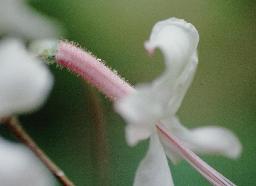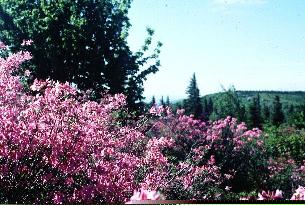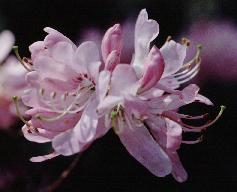


Next: The Orange Group
Up: Identifying the Natives
Previous: The White Group
 In the "Pink Group", there are five species:
R. canescens,
R. periclymenoides (formerly known as R. nudiflorum),
R. prinophyllum (formerly known as R. roseum),
R. canadense, and
R. vaseyi. The first two are often difficult to tell apart, but one distinguishing characteristic is that canescens usually has sticky, glandular hairs on the back of the floral tube whereas periclymenoides usually has plain fuzzy hairs without the sticky glands. Both species have long flower tubes and are fragrant. There are a number of excellent forms of canescens being offered in the trade now including the pale pink "Camilla's Blush" and "Varnadoe's Pink" with its red tubes and pink flowers.
In the "Pink Group", there are five species:
R. canescens,
R. periclymenoides (formerly known as R. nudiflorum),
R. prinophyllum (formerly known as R. roseum),
R. canadense, and
R. vaseyi. The first two are often difficult to tell apart, but one distinguishing characteristic is that canescens usually has sticky, glandular hairs on the back of the floral tube whereas periclymenoides usually has plain fuzzy hairs without the sticky glands. Both species have long flower tubes and are fragrant. There are a number of excellent forms of canescens being offered in the trade now including the pale pink "Camilla's Blush" and "Varnadoe's Pink" with its red tubes and pink flowers.
 R. prinophyllum is usually darker pink than the previous two species. It has a shorter flower tube and a distinctive cinnamon spice fragrance. One of the finest native stands of prinophyllum is at Dolly Sods Wilderness Area in West Virginia where the entire top of the mountain turns rose pink in early June. This region was virgin forest prior to 1770, but then severe logging by lumber companies devastated most of West Virginia near the turn of the century. By 1920, severe forest fires had ravaged the area.[1] The fires were so fierce in places that even the soil burned. Peaty soils built up by centuries of organic litter burned all the way down to bare rock such as that now seen exposed on Dolly Sods. This region is slowly recovering and the R. prinophyllum that is reclaiming mountaintop is a sight to behold.
R. prinophyllum is usually darker pink than the previous two species. It has a shorter flower tube and a distinctive cinnamon spice fragrance. One of the finest native stands of prinophyllum is at Dolly Sods Wilderness Area in West Virginia where the entire top of the mountain turns rose pink in early June. This region was virgin forest prior to 1770, but then severe logging by lumber companies devastated most of West Virginia near the turn of the century. By 1920, severe forest fires had ravaged the area.[1] The fires were so fierce in places that even the soil burned. Peaty soils built up by centuries of organic litter burned all the way down to bare rock such as that now seen exposed on Dolly Sods. This region is slowly recovering and the R. prinophyllum that is reclaiming mountaintop is a sight to behold.
 All of our East Coast native azaleas have exactly five stamens except for R. canadense and R. vaseyi. These two species are not closely related to the others natives and do not cross. However, they may be more closely allied with certain Asian species such as R. albrechtii and R. pentaphyllum from Japan or even R. schlippenbachii from Korea since these all have 10 stamens and also show similari
ties in flower form.
All of our East Coast native azaleas have exactly five stamens except for R. canadense and R. vaseyi. These two species are not closely related to the others natives and do not cross. However, they may be more closely allied with certain Asian species such as R. albrechtii and R. pentaphyllum from Japan or even R. schlippenbachii from Korea since these all have 10 stamens and also show similari
ties in flower form.
Canadense is generally a more northern plant, preferring cooler temperatures than we can provide in our southern gardens. Its upper three petals are fused into a separate lip and it has 10 stamens. At one time canadense was considered to be in a separate genus, Rhodora.
R. vaseyi on the other hand seems to be a very adaptable plant even though its original range was only from four counties in the mountains of North Carolina at elevations between 3,000 to 5,000 feet. Vaseyi usually has 6 or 7 stamens and comes in shades of deep pink to white. There is a superior pure white form called "Vaseyi White Find" that is readily available in the trade. Along the Blue Ridge Parkway in the Pisgah National Forest, there is an exceptionally deep rose form of vaseyi that people just refer to as "419.2", signifying the mile post where it is located. However, nurserymen will probably need a more marketable name if this plant is successfully propagated and offered to the general public.
The Blue Ridge Parkway from Cherokee to Grandfather Mountain is a magnificent drive whether or not vaseyi or the many other native azalea species growing along the roadside are in bloom. There are many excellent side hikes, including the spectacular rock outcroppings at Grandfather Mountain where R. vaseyi also grows wild. The Native American Indians considered the area at Grandfather Mountain sacred land, and so it should be with us.
There are many other places in the Appalachian Mountains that evoke similar feelings of inspiration and awe. Clingman's Dome, the highest point in the Smokies, is one such place although combined effects of acid rain and a foreign spruce adelgid introduced to the area have devastated the evergreen forests. The visitor's tower on top of Clingman's Dome does not fit with the natural beauty either, but in a 1000 years it will probably no longer exist but I hope the beauty of the surrounding mountains will still be there for people to enjoy.



Next: The Orange Group
Up: Identifying the Natives
Previous: The White Group
Donald W. Hyatt
2001-06-26
 In the "Pink Group", there are five species:
R. canescens,
R. periclymenoides (formerly known as R. nudiflorum),
R. prinophyllum (formerly known as R. roseum),
R. canadense, and
R. vaseyi. The first two are often difficult to tell apart, but one distinguishing characteristic is that canescens usually has sticky, glandular hairs on the back of the floral tube whereas periclymenoides usually has plain fuzzy hairs without the sticky glands. Both species have long flower tubes and are fragrant. There are a number of excellent forms of canescens being offered in the trade now including the pale pink "Camilla's Blush" and "Varnadoe's Pink" with its red tubes and pink flowers.
In the "Pink Group", there are five species:
R. canescens,
R. periclymenoides (formerly known as R. nudiflorum),
R. prinophyllum (formerly known as R. roseum),
R. canadense, and
R. vaseyi. The first two are often difficult to tell apart, but one distinguishing characteristic is that canescens usually has sticky, glandular hairs on the back of the floral tube whereas periclymenoides usually has plain fuzzy hairs without the sticky glands. Both species have long flower tubes and are fragrant. There are a number of excellent forms of canescens being offered in the trade now including the pale pink "Camilla's Blush" and "Varnadoe's Pink" with its red tubes and pink flowers.
 R. prinophyllum is usually darker pink than the previous two species. It has a shorter flower tube and a distinctive cinnamon spice fragrance. One of the finest native stands of prinophyllum is at Dolly Sods Wilderness Area in West Virginia where the entire top of the mountain turns rose pink in early June. This region was virgin forest prior to 1770, but then severe logging by lumber companies devastated most of West Virginia near the turn of the century. By 1920, severe forest fires had ravaged the area.[1] The fires were so fierce in places that even the soil burned. Peaty soils built up by centuries of organic litter burned all the way down to bare rock such as that now seen exposed on Dolly Sods. This region is slowly recovering and the R. prinophyllum that is reclaiming mountaintop is a sight to behold.
R. prinophyllum is usually darker pink than the previous two species. It has a shorter flower tube and a distinctive cinnamon spice fragrance. One of the finest native stands of prinophyllum is at Dolly Sods Wilderness Area in West Virginia where the entire top of the mountain turns rose pink in early June. This region was virgin forest prior to 1770, but then severe logging by lumber companies devastated most of West Virginia near the turn of the century. By 1920, severe forest fires had ravaged the area.[1] The fires were so fierce in places that even the soil burned. Peaty soils built up by centuries of organic litter burned all the way down to bare rock such as that now seen exposed on Dolly Sods. This region is slowly recovering and the R. prinophyllum that is reclaiming mountaintop is a sight to behold.
